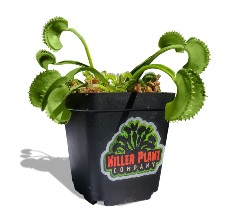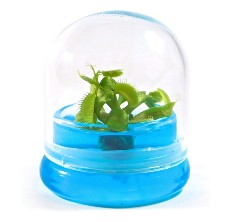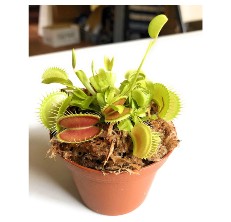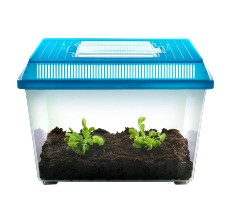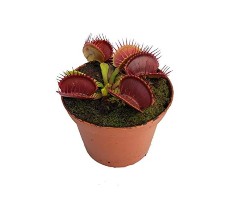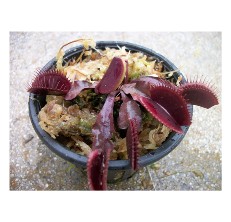- Flowers & PlantsVegetablesOur content is meticulously curated through independent research, testing, reviews, and AI-driven recommendations, all designed to present you with the finest product choices. When you make a purchase through our links, it could result in us earning a commission.
Best Venus Fly Traps Reviewed by Our Team
 Last updated: Apr 6, 2024
Last updated: Apr 6, 2024The Venus flytrap is a blooming plant that is most known for its carnivorous diet. Each leaf has two hinged lobes that serve as the “trap.” The trap will only close if the trichomes are touched several times, preventing the plant from wasting energy if no prey is present. The hinged traps include tiny bristles on the edges that interlock as the trap closes, preventing the victim from squirming out. You should get your hands on the top Venus fly traps in 2024 to catch flying insects.
Show contentsBest Venus Fly Trap Worth Considering for 2024- Killer Company Large Jagged Teeth Venus Fly Trap - Best Venus Fly Trap Overall
- BLOOMIFY Venus Flytrap - Runner Up
- Svetlana VR Venus Flytrap - Honorable Mention
- Nature Gift Venus Flytrap - Contender
- Predatory Plants Venus Flytrap - Also Consider
- Joelscarnivorousplants Red Dragon Venus Flytrap - Also Consider
Best Venus Fly Traps Buying GuideBest Venus Fly Traps Buying Guide
Venus Flytraps use delicious nectar to lure their prey. An electric charge shuts the trap, its interlocking teeth producing a cage, when you touch a trigger hair twice or two hairs in short succession. The trap will seal if the insect continues to fight, at which time digestive enzymes will destroy the victim’s delicate tissues. The trap absorbs the nourishing soup and, after approximately a week, reopens, attracting more visitors with the carcass. Here’s a guide to buying them.
What Are the Things to Consider Before Buying a Venus Fly Trap?
Growing location
Venus Flytraps require direct sunshine to thrive. If you’re growing your plant inside, select a sunny windowsill with plenty of light, particularly south-facing if you’re in the UK. Your flytrap’s leaves will grow weak and floppy as a result of insufficient sunlight, and the insides of its traps will be devoid of red coloration. They don’t need a terrarium to thrive. However, they do benefit from the increased humidity of the enclosed habitat. They may live happily in terrariums if their winter dormancy needs are met, and enough light is given. Artificial illumination, particularly high-powered fluorescents like T5 grow lights, can be effective.
Flowers and seeds
Venus Flytraps blossom in the spring, but unless you’re a seasoned grower who wants to harvest seed, you should cut off the flower stalk after it reaches approximately 5 cm in height. Flowering is taxing for Venus Flytraps, and most plants will grow more aggressively throughout the summer if they aren’t allowed to open.
Feeding
Venus Flytraps will capture more than enough food if they are cultivated outside. If you keep your plants indoors, you may feed them dead or live insects, but only after you’ve taken care of all of their other growth requirements. After the trap has closed, the trigger hairs must be triggered in order for Venus Flytraps to digest their meal correctly. This prevents the plant from wasting energy digesting non-edible materials that may have gotten stuck in the trap.
What Are the Factors to Look for While Buying a Venus Fly Trap?
Humidity
Venus flytraps prefer humidity. Thus they thrive in terrariums, and however, they can also thrive outside of them. As a result, they enjoy greenhouses and conservatories as well.
Winter dormancy
Place your venus flytrap somewhere chilly from November to February so it may fall dormant for the winter. It will lose its leaves, which will become black and die back. Remove any dead leaves and, if necessary, re-pot the plant in March before it starts to grow again.
Water
Many people wonder if tap water would kill a venus flytrap when they first start out, and the answer is yes. Venus flytraps cannot drink tap water because minerals will build up and destroy them. They require clean water. Feed them with rainwater or purified water. During the summer, keep venus fly traps submerged in 1cm of water to keep them hydrated. They should not be watered from above. The soil just needs to be moist, not wet, throughout the dormant winter months.
Soil
Venus flytraps must be planted in a high-acidity sphagnum-based soil mix. This may be purchased specifically for your plant. No fertilizer should be added to the soil.
What Are the Types of Venus Fly Traps?
There are several kinds and cultivars of this plant available for purchase and planting. However, they are virtually extinct in the United States. North and South Carolina are home to the native variety. These beautiful plants lure insects with delicious nectar, and when these naïve bugs contact the plant’s hairs inside the trap, it locks on them.
“Bohemian Garnet” Dionaea muscipula
This Venus flytrap plant is a 2007 hybrid between Dionaea’ Royal Red’ and Dionaea’ Sawtooth.’ It possesses the red color of the Royal Red plant, but the rest of the features are all from the Sawtooth plant. Miroslav Srba named it after the Czech Republic, where it was discovered. It is just 1.6 to 2.4 inches wide. It is known as Dionaea’ esk Granát’ in their language.
“Fused Tooth” Muscipula Dionaea
The webbed teeth that are visible throughout the summer are the most prominent feature of the Fused Tooth. It looks like any other Venus flytrap plant in the winter, and Peter D’Amato described it in his book The Savage Garden in 1998.
“Sawtooth” Dionaea muscipula
The teeth of this Venus flytrap are deep and split, and it was first reported in 2000 in its native North Carolina environment. It is crimson all around, with serrations on the traps’ edges. This Venus flytrap is much smaller and takes much longer to grow than regular Venus flytraps. It seldom grows larger than 2 to 3 inches in diameter.
“Wacky Traps” Dionaea muscipula
Cresco Nursery, based in the Netherlands, used tissue culture to clone this Venus flytrap plant. Mike Ross stumbled across it in a plate of mutant blooms. It has a resemblance to Bart Simpson’s hair from The Simpsons and is occasionally referred to as such. It has strong petioles and traps and grows slowly. It has a difficult time shutting its trap quickly. When the hairs in the trap’s “mouth” are activated, it takes the trap a long time to close. This plant was formally registered with the International Carnivorous Plant Society by Barry Rice in 2006.
“Big Mouth” Dionaea muscipula
The humorous name comes from the fact that this Venus flytrap plant has a huge mouth. Petioles, the leafy stalks that are part of the trap but in the soil, stand erect on this plant, which bears enormous, red-mouth-shaped traps. The petioles on this Venus flytrap are constantly short, so it resembles fangs and mouths waiting for its next meal as it develops. The inside of the trap is a deep crimson, while the outside is generally green. Some of the traps have a crimson color that extends beyond the teeth’ border.
Where Are Venus Fly Traps Commonly Found?
The Venus flytrap is native to North and South Carolina, although it has spread to neighboring states such as Florida and New Jersey. In many areas of the globe, it is popular as a potted plant, although most of the Venus flytraps marketed have been grown or taken from diminishing natural populations. The plant thrives in nutrient-depleted, wet, acidic soil. To survive, Venus flytraps require an open understory (the portion of the forest beneath the canopy). Natural fires that sweep over and burn away portions of trees and bushes help to keep the understory open. Since these flames may become harmful to humans, we typically put them out before they can aid the forests. As a result, the sun-loving Venus flytrap’s habitat starts decreasing.
Best Venus Fly Trap Worth Considering for 2024
1Killer Company Large Jagged Teeth Venus Fly Trap
– Best Venus Fly Trap OverallThese venus fly trap plants have already achieved maturity and are preserved during the shipping process, unlike conventional plants that must be grown from seeds. Each plant is guaranteed to arrive alive: if your plant arrives dead or damaged, the seller will replace or refund your order.
Perhaps the most well-known carnivorous plant, the venus fly trap is a fascinating and unusual addition to any plant collection. These plants are native to North and South Carolina’s marshy parts, and ideal for bright indoor terrariums, bog garden setups, and classic pots and planters.
Pros- Come already matured
- Makes great presents for plant lovers
- Ideal for indoor placement
Cons- Plant is smaller than the price paid.
2BLOOMIFY Venus Flytrap
– Runner UpDionea muscipula B52 is one of the biggest cultivars, having claws up to 2 inches long. These are grown in a gel medium that contains all of the nutrients and water they require to develop and thrive!
You may lift the top, pull the fly trap out, and plant it in 3 parts sphagnum peat moss and 1 part perlite once it has grown too large for the container, which generally takes 4 to 6 months. Your venus flytrap will have multiplied into over 30 plant clusters by this time, as well as grown in height and claw size.
Pros- This plant requires ZERO maintenance for up to 6 months
- Perfect gift for weddings, graduations, birthdays, and housewarmings
- There are no added fertilizers
Cons- The jar isn’t airtight, and the plant may come with mold in it.
3Svetlana VR Venus Flytrap
– Honorable MentionThis is an adult-sized plant that is alive and well. The plant is in a 3-inch container. This venus flytrap plant needs clean water, such as distilled, reverse osmosis (RO), or rainwater, to be in the best condition. Allowing your plants to dry out is a big no. This plant’s soil should be moist to the touch near its base.
While they can tolerate intense indirect light, it’s better to start with a low light setting to allow the plant to adapt gradually to the higher intensity. Carnivorous plants acquire most of their nutrition from their leaves rather than the soil, so feed them accordingly.
Pros- It comes as a mature plant
- There’s no need to re-pot because it’s already potted
- Sphagnum moss is included in the 3-inches pot
Cons- The plant slowly dies within a month or two.
4Nature Gift Venus Flytrap
– ContenderThis premium terrarium comes with two healthy, live, adult carnivorous Plants that are eager to chow down on some pests! Adult plants are 2 to 3 inches tall. Each Venus flytrap will have at least three traps.
In the accompanying peat planting mix and 1-gallon size planter terrarium with transparent sides, you can watch these intriguing plants grow. With meticulous care, these carnivorous plants will thrive for years in this specially constructed terrarium.
Pros- Adult plants are 2 to 3 inches tall
- Will thrive for years in this specially constructed terrarium
- Backed by a live arrival guarantee
Cons- They come healthy and alive but die after a short span.
5Predatory Plants Venus Flytrap
– Also ConsiderNothing else in the world compares to these bizarre plants with their fanged, gaping traps. You need to keep this venus fly trap plant needs in clean water, such as distilled, reverse osmosis (RO), or rainwater to ensure better growth. Follow the directions completely to increase the span of life of this venus fly trap. It helps you in getting rid of the pests by ingesting most of them.
Pros- This is an amazing plant to present to any science enthusiast child
- There are around ten large traps and numerous smaller ones on the plant
- Has a live arrival guarantee
Cons- Not an easy plant to maintain. It dies quickly.
6Joelscarnivorousplants Red Dragon Venus Flytrap
– Also ConsiderAll Red Dragon Venus Flytraps have the same genetic properties, and all are identical clones. They tan crimson to purple in intense light throughout the warmer part of the year. During the cooler months of the year, they may have more green than red on their leaves.
A live, healthy adult-sized Red Dragon Venus Flytrap Plant will be sent to you with a live arrival guarantee. It includes a 3-inch net pot with loosely packed moss suited for carnivorous plant soil and a thorough full-page care sheet.
Pros- Comes with a 3-inch net pot that holds a live, healthy adult-sized plant
- Includes loosely enough packed Sphagnum moss to fill your container
- No need for humidity domes to keep them alive
Cons- The plant isn’t packed well and may die during the shipment.
People Also Asked
Q: What is the diet of Venus Fly Traps?A: The Venus flytrap obtains part of its nutrients from the earth, but it also consumes insects and arachnids to augment its diet. The flytrap kills ants, beetles, grasshoppers, flying insects, and spiders. A Venus flytrap can digest a creature in three to five days, and it may go months without eating.
Q: What is the lifespan of venus flytraps?A: According to the National Wildlife Federation, individual traps in venus flytraps can only open and close a couple of times before they die and new ones grow up from the stem. A venus flytrap is supposed to survive for 20 years or longer if properly looked for; however, there is little scientific evidence to back this up.
Q: Is it possible to keep a Venus fly trap indoors?A: Among the carnivores, the Venus fly trap is arguably the most well-known. Carnivorous plants are not difficult to grow indoors, as long as you provide them with a bug-free environment. A sun porch window with frequent opening and closing doors to let in insects are ideal.
The Garden Gate Review Team’s product reviews and in-depth guides are here to help you choose the best products for a beautiful and bountiful garden and backyard. The content is created by The Garden Gate Review Team. Garden Gate’s editorial staff is not involved. Garden Gate is reader-supported: When you buy through links on our site, we may earn an affiliate commission. The Garden Gate Review Team is composed of authors, editors, and gardeners. Artificial Intelligence (large language models) may have been used in the research and creation of the content. Please reach out to aimperiapt@gmail.com with any questions regarding product testing or specific articles.
